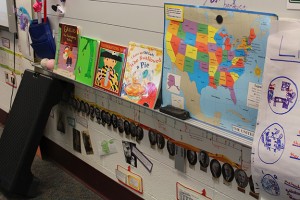Diverse Teachers Critical For Indiana’s Ever-Evolving Population
Think about your favorite teachers. What drew you to them?
Maybe they helped you enjoy a subject you didn’t particularly like, or made you feel comfortable in a new classroom setting. In short, you most likely felt like they could relate to you.
Having teachers who can work with a wide range of student experiences is especially crucial to ensure success for children who come from diverse backgrounds. But it can also be difficult to find those teachers – especially in Indiana’s current educational environment.
Here’s something we all know by know: Indiana is experiencing a teacher shortage. In considering solutions for recruiting new folks and retaining existing personnel, state education leaders have said that attracting diverse teachers has to be part of the conversation.
- Directing DiversityIndiana education leaders say that attracting diverse teachers has to be part of the conversation around the state’s teacher shortage – specifically English Language Learning instructors. ELL teachers are hard to come by in Indiana as well as in other states – and with such a limited number of these specialists, the expectation is that they’ll be the expert in not just one language, but be able to speak and relate to students from all cultures represented in their student population. StateImpact Indiana’s Rachel Morello reports.Download
Building Relationships With Instruction
Many of the students Sarah Laptiste meets as kindergarteners at Clinton Young Elementary School will stay in her classroom until they go on to middle school around age eleven.

A map of all the home countries of students and their families graces the bulletin board outside Clinton Young Elementary School ELL teacher Sarah Laptiste’s classroom. (Photo Credit: Rachel Morello/StateImpact Indiana)
“Some of the kids, I remember when they were born – I’ve had all their brothers and sisters,” Laptiste says with a smile, reflecting on her 11 years at the school. “Fifth graders I have in here, I remember when they were in kindergarten. There’s a lot of history between us and I know their parents very well. We’ve been together a long time.”
This relationship and the continuity it provides makes Laptiste different from all the other “regular” teachers her students encounter. It also makes her well-suited to deliver the kind of instruction these specific students need: learning the English language.
Laptiste is one of two certified English Language Learning, or ELL, instructors at her school – along with an ELL facilitator, two ELL aides, and a translator. Of the approximately 700 K-5 students attending Clinton Young, about 30 percent are classified as English learners. In total, nearly one-third of the 15,000 kids Perry Township serves district-wide are ELL students. For the most part, these students’ primary languages include Spanish and Burmese, or Chin, a language spoken in southern Asia.
Clinton Young is part of the Metropolitan School District of Perry Township, a corporation on the south side of Indianapolis that’s home to a large concentration of Chin people. As a state, Indiana lays claim to one of the largest populations of people from Burma, also known as Myanmar, outside of the country itself.
Other cities and towns are in similar situations. The Hoosier state houses emigrants from Mexico, India, China and the Philippines, just to name a few.
According to the national Center for Immigration Studies, one in five Americans speaks a language other than English as home – that’s 63.2 million people, and growing. That applies to 22 percent of school-age children.
Jane Pollard, Perry Township’s Administrator for ELL and Professional Development, says the kind of targeted instruction Laptiste and her colleagues provide is critical to properly serve their student population.
“If you’re an ELL learner, if you’re a special education student, if you’re a student who lives down the street, you have some unique needs,” Pollard says. “It’s our job as educators to find out what those learning needs are, and to do our best to meet those needs.”
“All kids, even if they’re all of similar ethnicity, they’re still all different,” adds Clinton Young Principal Andrea Korreck. “They’re kids. They deserve the very best from us, no matter who they are.”
Specialists In Short Supply
But as in many other subjects, ELL teachers are hard to come by. Right now, Indiana serves about 62,000 students with limited English proficiency – but only employs around 900 certified ELL instructors.
That adds up to a student-teacher ratio of 60-1. Typically, the ideal ratio sits closer to 30-1.

Decorations in Sarah Laptiste’s classroom at Clinton Young Elementary School. (Photo Credit: Rachel Morello/StateImpact Indiana)
State policymakers are working to figure out a way to fill in the gaps left in Indiana’s teaching force. State Superintendent Glenda Ritz’s Blue Ribbon Commission, a group organized to respond to Indiana’s teacher shortage, says the state needs to “recruit and retain teacher candidates from underrepresented populations.”
According to Rachel Davidson, Coordinator of English Learning and Migrant Education for Indiana’s Department of Education, that includes educators with skill sets to relate to and communicate with students from all different backgrounds.
“We want to make sure that they understand that different cultures have different nuances, as do different languages,” Davidson explains. “We want them to come out prepared to work with any and all students in their classrooms, including students that are culturally and linguistically diverse.”
That’s where teacher prep programs come in. Davidson says it’s critical for teaching candidates to graduate with a full understanding of Indiana’s state-adopted English language proficiency standards, called the WIDA standards.
“Our population in the state has drastically changed over the past ten years,” Davidson explains. “School corporations are adjusting to try and find teachers that will help connect with those students and give that perspective to their student population.”
Faridah Pawan trains teaching candidates working toward their ELL certification at IU’s School of Education. She says one way IU preps these future educators is by requiring them to have similar experiences to their future students, learning one or more foreign languages.
“You have to have that experience of not just frustrations, but coping strategies, developmental stages that you go through to learn a new language,” Pawan says.
IU also pushes the idea of developing content area expertise. The school encourages general education teaching candidates to pursue dual certification in ELL, not only to expand teachers’ toolboxes, but to add to the pool of qualified candidates for open jobs.
Pawan says the strategy has been successful – the school has seen a 20 percent increase in the number of graduates finishing school with an ELL certification in recent years.
‘It doesn’t matter who walks in that door’
For schools where hiring new ELL staff isn’t an option, there are opportunities to expand the skill sets of their current roster of educators.
—Denita Harris, Curriculum Coordinator, MSD Wayne Township
Just a few miles northwest of Perry Township, Wayne Township Curriculum Coordinator Denita Harris oversees the district’s ELL program. Beginning in January, general education teachers in her district will have the opportunity to earn their ELL license for free through a partnership with Purdue University.
She says this training is critical because it is up to schools to act as neighborhood hubs, to create communities through instruction and inclusion.
“It doesn’t matter who walks in that door, it’s our job to teach them,” Harris says. “It’s our job to celebrate who they are. It’s our job to find out what gifts and talents they bring to us, and it’s our job to bring up those things that are hidden.”
Back at Clinton Young Elementary, Sarah Laptiste works with students who are often the first in their families to attend school in America. She makes this pitch to potential teachers to consider ELL as their specialty:
“I don’t have kids of my own yet, but it’s been like being a second mom, or watching them grow up,” Laptiste says thoughtfully.
And, she adds, it helps you grow, too.
“I think one of the advantages of ELL is you get to co-teach with so many different people that are very different styles from you, and kind of just build your skills based on just kind of absorbing what other great teachers do,” Laptiste says.
Podcast: Play in new window | Download